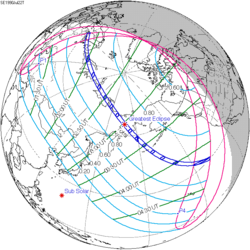| Hybrid eclipse | |
| Gamma | −0.8538 |
|---|---|
| Magnitude | 1.0005 |
| Maximum eclipse | |
| Duration | 2 s (0 min 2 s) |
| Coordinates | 69°06′S144°30′E / 69.1°S 144.5°E |
| Max. width of band | 3 km (1.9 mi) |
| Times (UTC) | |
| Greatest eclipse | 23:51:58 |
| References | |
| Saros | 121 (51 of 71) |
| Catalog # (SE5000) | 9153 |
A total solar eclipse occurred at the Moon's ascending node of orbit between Thursday, October 30 and Friday, October 31, 1845, with a magnitude of 1.0005. It was a hybrid event, with only a fraction of its path as total, and longer sections at the start and end as an annular eclipse. A solar eclipse occurs when the Moon passes between Earth and the Sun, thereby totally or partly obscuring the image of the Sun for a viewer on Earth. A total solar eclipse occurs when the Moon's apparent diameter is larger than the Sun's, blocking all direct sunlight, turning day into darkness. Totality occurs in a narrow path across Earth's surface, with the partial solar eclipse visible over a surrounding region thousands of kilometres wide. Occurring about 3.4 days before perigee (on November 3, 1845, at 10:40 UTC), the Moon's apparent diameter was larger. [1]
Contents
- Description
- Eclipse details
- Eclipse season
- Related eclipses
- Eclipses in 1845
- Metonic
- Tzolkinex
- Half-Saros
- Tritos
- Solar Saros 121
- Inex
- Triad
- Solar eclipses of 1844–1848
- Saros 121
- Metonic series
- Tritos series
- Inex series
- See also
- References
- External links
The greatest eclipse was in northeasternmost Antarctica south of where the Indian and Pacific Ocean divides at 69.1 S and 144.5 E at 23:51 UTC (9:51 am on October 31), in that portion of Antarctica and the surrounding waters it shown as a total eclipse, the remainder was as an annular, first in the Indian Ocean then in the Antarctic Peninsula. [2]









































































































